By Carol Woodbridge Mulder © 1988
** Originally published in the July August 1988 issue of The Crabbet Influence magazine. Also published in The Crabbet Influence's 1993 Collector's Volume II.
Abu Farwa 1960 was, without question, one of the greatest American-bred Arabian stallions of all time and he is recognized as such throughout the Arabian horse breeding world. Yet, few breeders/owners of today have accurate knowledge of this horse.
Abu Farwa was foaled May 22, 1940. He died July 22, 1972, at age 32. This longevity made him somewhat unusual, but the true uniqueness of it becomes more apparent when we consider that his sire, Rabiyas, died at age 31 and his great-grandsire, Gulastra, at age 30.
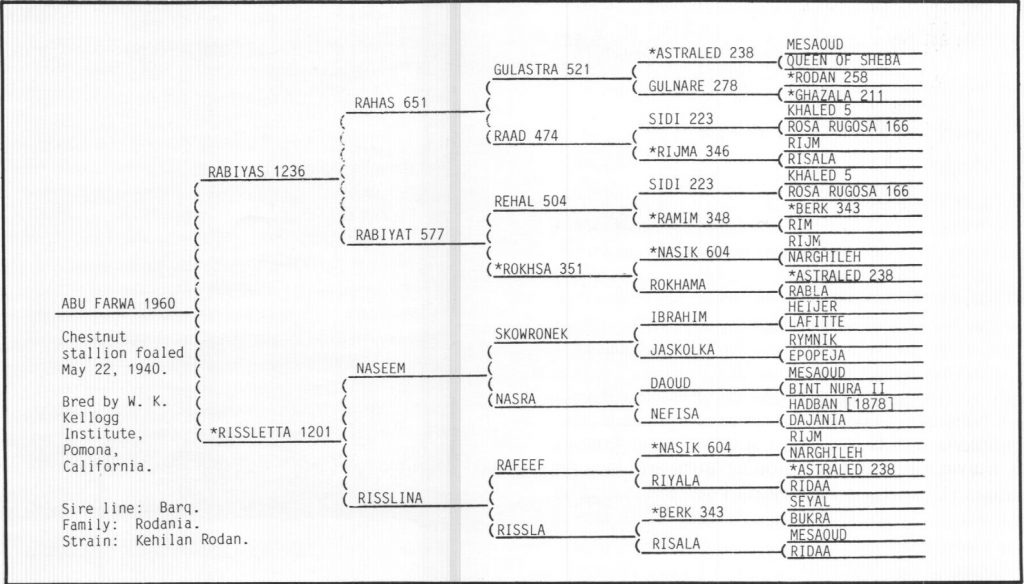
Abu Farwa was on the leading sire list for some years and two of his sons, Abu Baha and Ga'Zi, were also on it; one year Ga'Zi was the leading sire in North America. Abu Farwa sired two different broodmatrons, Abuseyna and Almiki, who produced two significant American racers - Michael 7460 and the great Kontiki 22843. Abu Farwa stock has not only done exceptionally well in American flat racing, but also in endurance and in shows where Abu Farwa-bred horses have won countless blues and championships in halter, English, and western. Abu Farwa was known for his trotting action and for his ability to pass it on. Today, sixteen years after his death, Abu Farwa blood is prized for its strong ability to frequently breed on his own special qualities. He has descendants in some foreign countries, such as New Zealand, Australia and England, as well as throughout the United States and Canada.
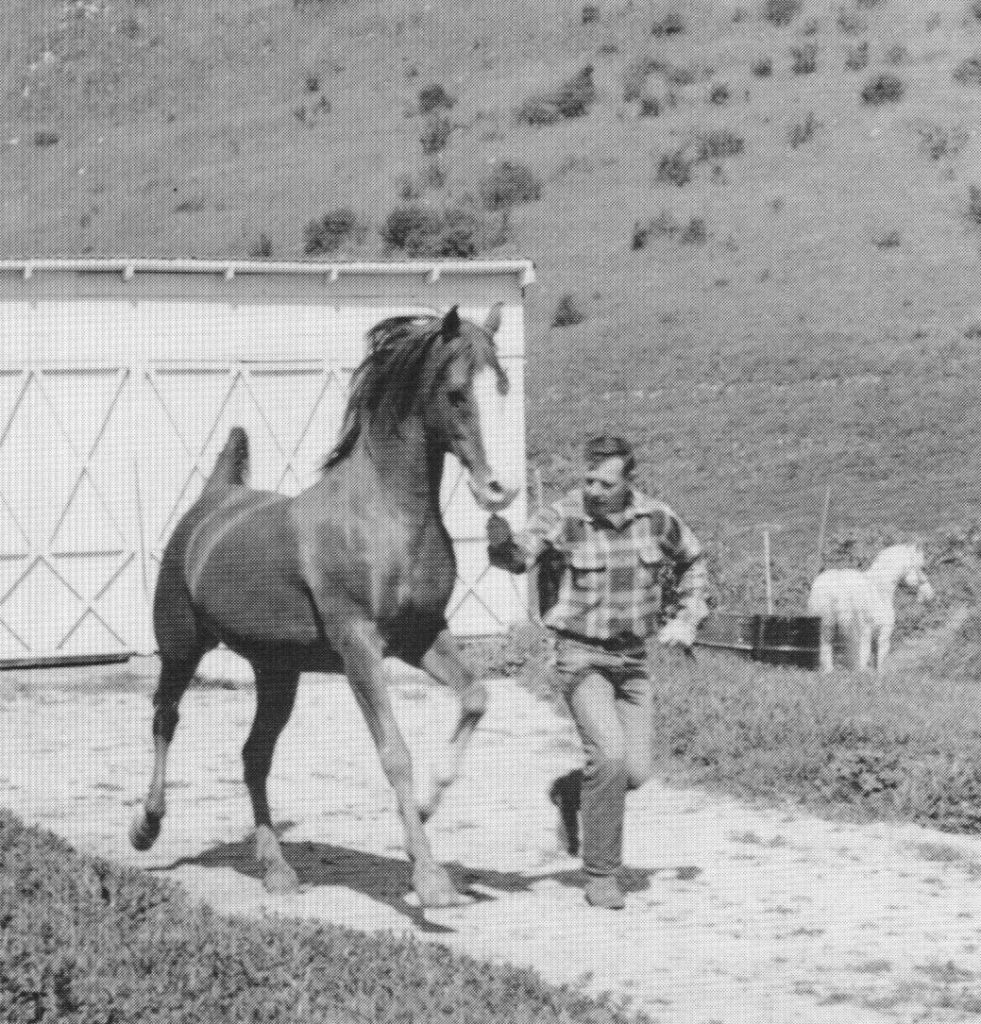
As an individual, Abu Farwa was totally magnificent. He stood 15.1 ½ hands. He was a solid red chestnut with a self-colored mane and tail. He had none of his dam's roaning in the coat, although he did have some faint flecking on his sheath. He was marked with a broad expanding blaze and a left front three-quarter stocking. He was a perfectly balanced horse of classic Arabian type and style. He had a very fine, dry head with a gentle jibbah and dish. His ears were small and especially neat. His eyes were average. His neck was a legacy from his dam and maternal grandsire, Naseem, and was one of his most elegant features. It was long, clean, and perfectly shaped with an excellent mitbah and beautiful joining of head and neck. The windpipe was loose and pliable. Ab's neck was so perfectly constructed that he had a constant natural light arch, even when dozing on his feet. He was never sweated in his life - he never needed to be as his neck came from his genes. In his very late 20's, however, Ab's throat thickened from some sort of age trauma; this condition never existed in his youth, prime, middle-age, or early 20's. His neck came out of his shoulders well. The shoulders were long, of excellent slope, and well laid back. Ab's withers were considerably better than average. His back was good and it never went down, remaining strong and youthful looking even in his extreme old age. He had good depth through the heart and his topline and croup were good with a correct pelvic structure. His tail, which was set on well, was carried in a high, gay arch in the very best Arabian tradition. Ab inherited in some small degree his dam's tendency for the tail hairs to wave, although this did not seem constant with him as it was with her. From the side view, Abu Farwa's legs generally were of good proportion, except for being slightly shorter in the pasterns than is ideal, and in perfect plumb, as were his front legs from the front view. While most of the time he stood correctly on his hind legs from the rear view, he sometimes stood slightly cow-hocked. (No horse is perfect and no perfect horse will ever be foaled; few of our modern champions can be said to compare in an entirely favorable light with Abu Farwa for most have greater faults and lack his superiority in so many areas.) Overall, Abu Farwa had good legs and he was unusually consistent in correcting side view alignment in his get - a problem area in many Arabians today. In his advanced age, Ab developed arthritis in his front legs and knees. This condition apparently first made itself known when he was about 24 years old - an age when most horses are already dead.
One of Abu Farwa's most breathtaking traits was his entirely natural, inherited trotting action. He was particularly noted for his unusually lofty, airy, and well flexed front action; his hock action was not quite equal. Abu Farwa's trot was remarkable in another way too; he was one of the very few Arabians who floated correctly at the flexed stage of his gait and not at the extension stage. The latter condition is a serious flaw caused by a short stride in front and the horse's strained attempt to prolong stride and retain necessary synchronization with the hind legs coming on; this is called 'dwelling' and is an inherited motion aberration. Abu Farwa had no such motion flaw with his correct float, which was more like a breathtakingly beautiful, light ballet. His trot was so exceptional and unusual that watching it was awesome.
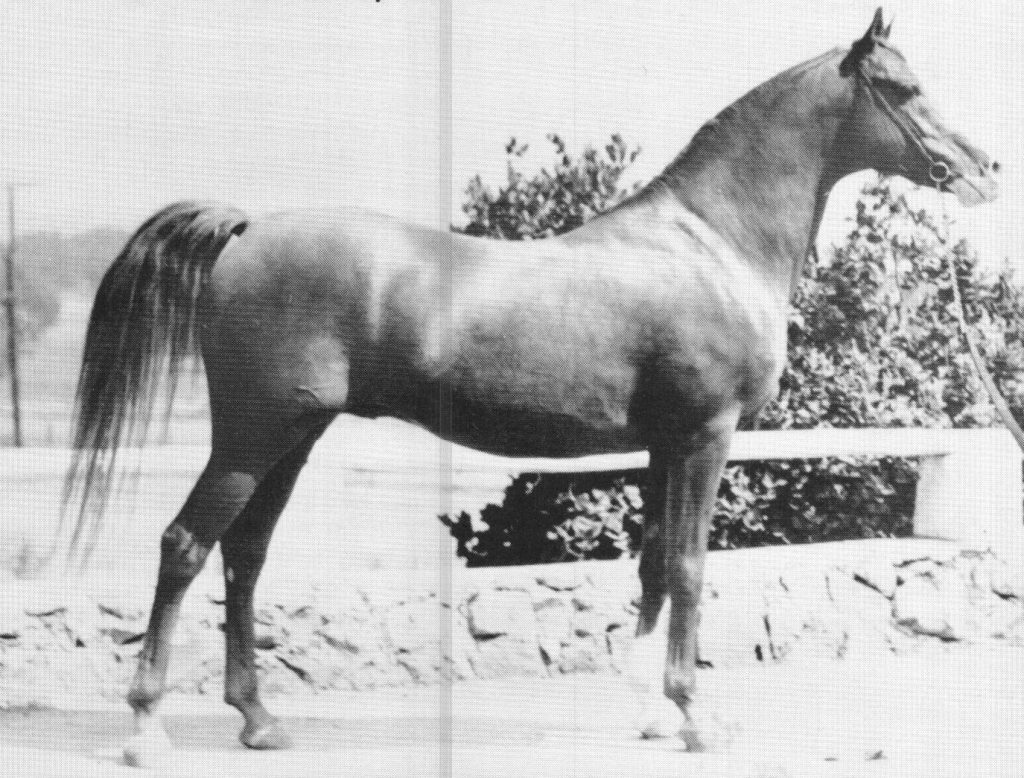
Abu Farwa was bred and foaled at the famous old W.K. Kellogg Arabian Horse Ranch, Pomona, California. His pedigree represents the ultimate of the finest old Crabbet/American, or more specifically Crabbet/Kellogg, breeding.
Rabiyas, the sire of Abu Farwa, was bred by W.R. Brown at his Maynesboro Stud, Berlin, New Hampshire. His dam, Rabiyat, had been purchased from Mr. Brown by Mr. Kellogg in September 1935 while pregnant with Rabiyas, who was foaled at the Kellogg Ranch on May 15, 1936. Abu Farwa was in the first foal crop of Rabiyas, gotten when the horse was just 3 years old. Standing 15.1 hands, Rabiyas was a red chestnut with a blaze, left front coronet, and full stockings on his other three legs. He was a well-made, upstanding horse with a long neck and good shoulders. He had particularly good leg alignment from the side view with excellent strong joints. He had a gay, arched Arabian tail carriage and some style in his manner of carrying himself. His face was very Arab looking and typy. His croup, however, was somewhat rounded. Another writer, who never saw the horse, has incorrectly described Rabiyas as plain and angular, but the only plain thing about him was his head in profile and he was not at all angular - quite the opposite! Rabiyas had bold action and extreme presence. Because of his natural high action at the trot, he was first trained to drive. Later he was a regular featured performer in the famed Kellogg Sunday exhibitions where he gave very good demonstrations of an Arab as a five-gaited horse doing the walk, trot, canter, slow-gait, and rack; his speed and flair at the latter gait were very credible and his slow-gait was stylish. Rabiyas was considered one of the best of the Kellogg sires. He was sold in October 1949 during one of the post-World War II U.S. Army sales (Mr. Kellogg had given his ranch and horses to the U.S. Army Remount Service during World War II). His buyers were Donald C. and Charles H. McKenna, Claremont, California. In 1954 they sold him to P.S. Van Der Merwe, Cape Province, South Africa, where he died in the spring of 1967.
Rahas, the red chestnut 15 hand sire of Rabiyas, was chief stallion at the Hearst Ranch, San Simeon, California. He was trained to ride and drive. His sire, chestnut Gulastra, was the founder of his own very important breeding dynasty in the U.S. Rabiyat, the bay dam of Rabiyas, was one of the most brilliant moving Arabs of all time and was an imposing presence who was also an outstanding broodmare.
Abu Farwa's dam was the very lovely *Rissletta. Bred by Crabbet Stud in England, she was foaled in 1930 and imported for Mr. Kellogg in February 1936. A light chestnut, she was marked with a blaze, left front stocking, left hind three-quarter stocking, and right hind sock. She had roaning in her coat, mostly on her barrel, flecking at her flanks, and a roan tail dock. Her mane and tail were naturally wavy. She stood 14.1 hands. This high caste, ultra-classic mare was known for the beauty of her fine head and neck; no matter how she used her neck, it always remained lightly arched and displayed a clean Arab mitbah. She was, however, rather crooked in her hocks from the side view. I particularly remember *Rissletta's unusually sweet disposition; I knew her well when I was a child. I used to climb over the top of her stall door and drop in to visit her when she had a new foal. She always received me with serenity and kindness. I used to crawl about under her belly and between her legs as I tried to pet her various foals. In addition to the traits already mentioned, *Rissletta also had a good trot. She was an outstanding producer whose foals could usually be counted as among the best their sires ever got. *Rissletta died October 18, 1954, at age 24.
Naseem, the gray 14.3 hand sire of *Rissletta, has emerged with the passing of time as one of the world's greats among Arabs. He has successful descendants in many countries, including Russia, Poland, The Netherlands, England, the United States, Canada, South Africa, and Australia. Abu Farwa was one of the most eminent and best of the coveted Naseem grandsons. Like his daughter, Naseem was known for the fine quality of his head and neck. Naseem was sired by the Polish Skowronek, perhaps the most successful Arab sire of all time. Risslina, dam of *Rissletta, was a renowned English matron with considerable influence on modern English Arabs. A chestnut, she was stylish and had a good trot.
It can be seen that Abu Farwa came from excellent stock and had a pedigree heavy with great and/or renowned individuals. Besides those already mentioned, in his five generation pedigree there were three crosses to *Astraled, a good mover, three crosses to Mesaoud, who was the single important early Crabbet sire, two crosses to *Berk, famed as a progenitor of good trotting action, two crosses to *Nasik, who had a very good trot and is today considered one of the most important Crabbet stallions imported to America, and two crosses to the great matron Ridaa. Abu Farwa had two crosses, via his sire, to Sidi, one of the most influential American sires of the 1920s; Sidi also had a good trot.
For those interested in pedigree percentages, Abu Farwa was 90.6% Crabbet (considering Skowronek Crabbet because that stud made him great) and 9.4% non-Crabbet English.
A 1942 chestnut full-brother of Abu Farwa, Rabilett 2342, was put down at age 2 because his back was lower than was acceptable at the Kellogg Ranch, which had extremely high standards; in my travels, I have seen other studs retain and breed from similarly conformed animals. Rabilett was the only one of *Rissletta's foals which was seriously flawed. Abu Farwa's 1943 full-sister, Joanna 2592, a very beautiful and classic mare of quality, quickly became a major show champion of her era. Joanna, much like her dam, had a good deal of roaning in her coat. Rossletta 6925, Abu Farwa's 1951 full-sister, was a true chestnut roan with a chestnut head and chestnut legs above her markings, but she had an unusual factor to her lovely shimmering color in that there was a brindle pattern of chestnut running through it. She had a white dock to her tail. A very high class individual and one of *Rissletta's best daughters as well as her last foal, Rossletta was, unfortunately, foaled during the dismaying, damaging, and ignorant anti-color/anti-marking prejudices which sadly existed in this country during her era and so she was sold without papers. I have always felt this was a dreadful mistake and a loss to the breed because Rossletta had very real merit. It is important to mention here that low backs, such as Rabilett's, have never been a problem in either Abu Farwa's or Joanna's lines. Besides the described full siblings, Abu Farwa also had several very high quality half-siblings (out of *Rissletta, but sired by stallions other than Rabiyas).
Abu Farwa was sold from Kellogg's as a weanling for $400. That was the usual California price in 1940 for quality colts of that age (six to twelve months). His purchaser was Paul Paul of Fresno, California. When Ab was two years old, Mr. Paul sent him down to Covina, California, to H.H. Reese to be sold. Mr. Reese, former manager of the Kellogg Ranch, immediately recognized the tremendous potential of Abu Farwa and bought him himself. Thus, Abu Farwa became the third and youngest member of a trio of Reese stallions which for many years were the three most popular Arabian sires in North America - Alla Amarward 1140, Ferseyn 1381, and Abu Farwa. This was truly a remarkable achievement and a tribute not only to the stallions, but also to their long-time owner, H.H. Reese.
At age 2, Abu Farwa was bigger than average, very alert, and full of himself - he was rambunctious. He was not a colt the inexperienced could control with ease. Yet, this unmannered - almost unruly - colt was remarkably tolerant and docile when, soon after Mr. Reese bought him, I, as a girl of 10, went up to him while he was being shown to my father and began to tug at one front leg so I could see his foot. He simply handed me his foot! I am not going to reveal what Mr. Reese and my father said to me.
Abu Farwa was trained to ride both western and English. He was shown in halter and under English tack successfully - but on a very limited basis - and was himself a champion. Although not trained for stock work, he was sometimes utilized to help herd the Reese cattle.
Mr. Reese leased Abu Farwa out on at least three occasions - to Catherine Richardson, to Dr. Harold West, and during 1952/1953 to Ab's birthplace, the Kellogg Ranch, which was then California State Polytechnic College. At Kellogg's he was used as a sire and also in the Sunday exhibitions. For these the 12 year old Abu Farwa was finished into a really polished three-gaited horse by the master trainer, Charles A. Smith.
It was while he was at the Kellogg Ranch on lease that I first realized that Abu Farwa might have had running speed. He had never in his life been asked to run and he had not since foalhood been turned out in an enclosure big enough for him to 'open up,' but one morning he was turned loose in the very large Kellogg show ring. This arena was of a size sufficient to accommodate an eight-horse Percheron hitch with show wagon running full speed and for this team with wagon to maneuver about in skilled displays of driving. I watched Ab gallop easily from one end of this ring to the other, but he seemed to be only 'coasting' without effort - a sort of cruising engine idle - and with thrilling controlled latent reserve power, despite the fast speed at which he was covering the ground. I realized that the big ring was not long enough for this horse to move out and launch himself into a full run, although the Percherons did it - with an appearance of great effort on their part - and many of the other Kellogg Arabs could and did run there. I wondered then what Abu Farwa could do if he had room to shift gears and accelerate into his real run, unleashing all that latent, contained, power which seemed so obviously there. The thrill of his powerful, effortless, casually floating gallop, with the promise of so much more in reserve just waiting to be let out, almost made my hair stand on end and I have never forgotten the unusual sight. I never did get to see this horse really run; I do not think he ever in his life had opportunity to do so.
Abu Farwa spent several years at Mr. Reese's stud in Covina. Eventually Mr. Reese moved his Arabians to his large ranch at Chino, California. There Ab lived for many more years, occupying a large paddock on a gently sloping hillside. He was left out except during inclement weather, during which he was brought into the barn and stalled. After so much freedom, he never cared for this at first and expressed his frustration by doing a piaffe in his stall and loudly popping his lips. Soon, however, he would become accustomed to the confinement and grow quiet.
During this period of his life, Abu Farwa was sculptured by the very talented artist, Maureen Love, later Mrs. Calvert. The result of her many hours of sitting in Ab's paddock with him wandering about was a very true-to-life likeness which was sold for a short time as well done, individually finished, artistic ceramic work. These beautiful works of art are now collector items and very rare, but for many years cheap facsimiles in plastic were sold in variety stores.
Ab always enjoyed the company of other horses. Having a neighbor in the paddock next to him kept him quiet and happy. Often these neighbors were weanlings - he was very good with youngsters.
Later, when Mr. Reese's health began to fail, he sold his big ranch and cattle and moved his horses just down the lane to a smaller place. There Abu Farwa had a box stall which opened into a corral which he could use at will.
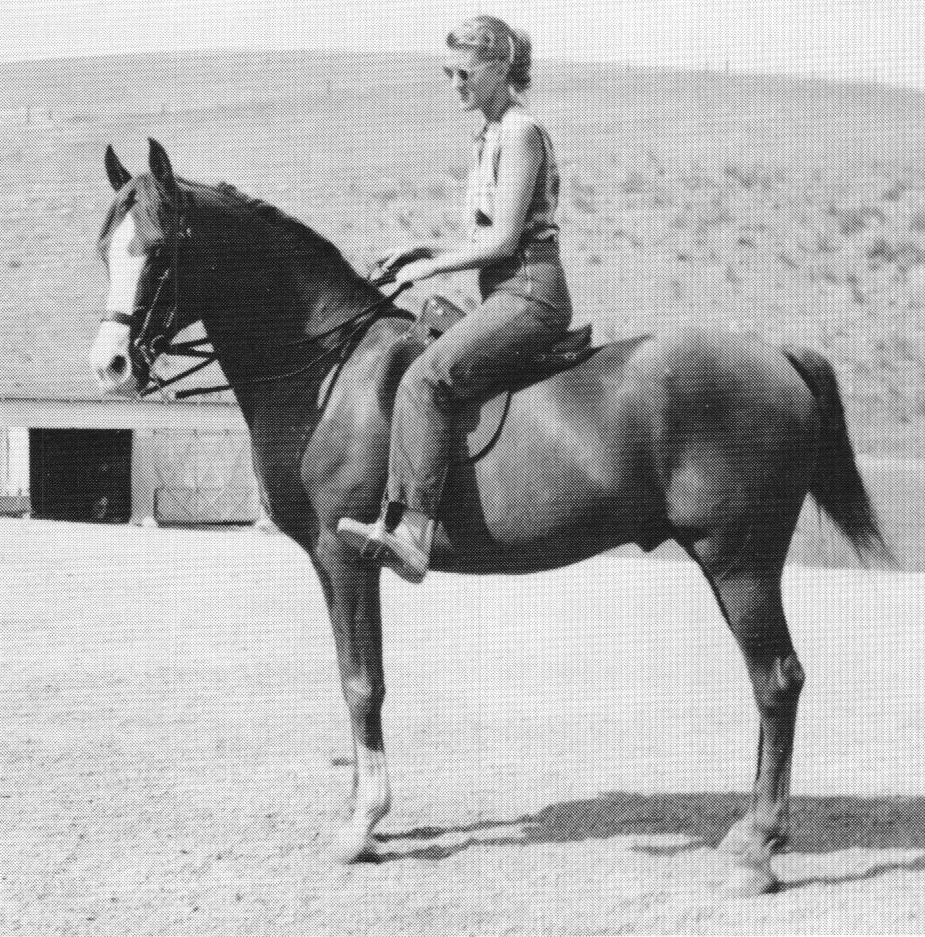
Handling and riding Abu Farwa in his prime and middle-age were different from handling and riding the other Reese stallions. At that time in his life, I often handled and groomed all three of the Reese stallions. Alla Amarward was very easy to handle - always a perfect gentleman whose primary goal in life was to please and who, under ordinary circumstances, was as quiet and trustworthy as a pet gelding. Ferseyn had to be watched every moment for the little games and tricks he delighted to think up and play, with a good-natured, foxy attitude of fun. Sometimes I thought he was positively laughing at some of his own successful pranks and I know he thoroughly enjoyed executing them. Abu Farwa was different. He had a superior attitude and a way of looking through, over, and beyond me that made me feel quite unimportant, insignificant, and small. Every now and then he would 'speak' to me when I was handling him. He did this by very briefly fixing his attention on me diverting it from where it had been at some far spot seemingly miles away - and turning his head to touch me with his muzzle, but then he would immediately resume the attitude that I was not there at all. I rode Ab once, when he was 16 years old and I was 24. It was a thrilling experience, never to be forgotten - the ride stands out clearly in my mind today, 32 years later. It was very difficult to keep Abu Farwa's attention on the job at hand as he found things miles away of more interest. He gave the impression that he possessed unlimited, ever increasing power; indeed, he gave the illusion he was swelling up bigger and bigger with more and more power. He was not a horse who induced relaxation in his rider. He preferred not to notice his rider and it took hard work on my part to keep his mind and body where I wanted them in order to get a ride.
Ill health finally made it necessary for Mr. Reese to sell his beloved horses. Ferseyn went first - to Frisco Mari, California. Later Abu Farwa and Alla Amarward, along with several others including El Gato 9075, *Mohacz 18277, *Ardahan 18278, and some mares, went to Charles Doner, Elsinore, California. Alla Amarward died October 14, 1961, at age 26. Ferseyn died November 6, 1962, at age 25. Mr. Reese passed away April 7, 1963, at age 78. Abu Farwa lived on another nine years under the very excellent care of Mr. Doner.
Abu Farwa got his first foal at age 3 and was an immediate success as a sire. At that time there were approximately 2500 living registered Arabians in North America. Ab got his last foals when he was 30 years old; there were then about 60,000 living pure Arabs in the United States and Canada. During his long stud career - twenty-eight seasons - he got 144 purebred daughters and 133 purebred sons, making a total of 277 registered Arabian foals. Some 29% of his get - 71 sons and 10 daughters - never reproduced. There were probably many reasons for this, among them no doubt some accidental deaths, but I know that this nonproductive group also included a few of Ab's best offspring, such as, for example, Farmal 9277, and it is sad to contemplate their unfortunate loss to posterity. The remaining 71% of Abu Farwa's get - 62 sons and 134 daughters - have to date sired and produced about 3000 Abu Farwa grandget, not all of which are living.
From such a large list of Abu Farwa get, it is obvious that only a relatively few individuals can be specifically mentioned in this limited space, but some, for reasons of their fame or because they are known by me to still be alive today, will be named to give an idea of the influence of Abu Farwa blood.
Among the Abu Farwa sons were such as:
Tamarlane 3274 (x Ritama 1686 by Rifnas 924) 1945 chestnut - Flowers, CA - 33 get
Abu Allah 3582 (x Sharid 2265 by Alla Amarward 1140) 1946 chestnut - Geimer, CA - 11 get
Abu-Alla-Altair 3770 (x Alla-An 2231 by Alla Amarward 1140) 1946 chestnut - Boyer, CA - 23 get
Faryn 3806 (x Ferdith 1920 by Ferseyn 1381) 1946 chestnut - Boyer, CA - 47 get
Nirahbu 3915 (x Nirah 1051 by *Ferdin 613) 1946 bay - Doesken, CA - 38 get
Allabu 4329 (Alla-An 2231 by Alla Amarward 1140) 1947 chestnut - Boyer, CA - 16 get
Vabu 4540 (x Valla 2537 by Alla Amarward 1140) 1948 chestnut - Jorgenson, CA - 15 get
Abu Baha 4676 (x Surrab 2412 by *Latif 1454) 1948 chestnut - Reese, CA - 118 get
Ga'Zi 5162 (x Ghazna 2694 by Chepe-Noyon 1303) 1949 chestnut - Mekeel, CA - 266 get
Tabu 5175 (x Tahir 2413 by Antez 448) 1949 chestnut - Lowrey, CA - 23 get
Antezeyn Skowronek 5321 (x Sharifa 2951 by Antez 448) 1949 chestnut - Boyer, CA - 113 get
El-Zarib 5738 (x Alla-An 2231 by Alla Amarward 1140) 1949 chestnut - Boyer, CA - 28 get
Awad 6129 (x Shamrah 2403 by Balastra 1590) 1950 bay - Hinckley, CA - 23 get
Zimri 6295 (x Zamba 2279 by A'zam 1353) 1950 bay - Siburg, CA - 12 get
Abuzim 6501 (x Zimada 3946 by Ziyadi 2049) 1950 chestnut - Campbell, CA - 47 get
Koester 7119 (x Fredrika 4159 by *Raseyn 597) 1951 gray - Williams, CA - 18 get
Suhbi Sadik 7425 (x Ferdeyna 1135 by *Raseyn 597) 1952 chestnut - Goforth, CA - 50 get
Farlowa 8545 (x Farlouma 2345 by Farana 708) 1953 bay - Cal Poly Col, CA - 147 get
Shahzada 9021 (x Surrab 2412 by *Latif 1454) 1954 chestnut - Robson, CA - 107 get
Abu Kali 10550 (x Kalilah 2925 by Sahiby 1549) 1955 chestnut - Elbon, CA - 13 get
Muhuli 11717 (x Follyanna 5193 by Terhani 1640) 1957 chestnut - Richardson, CA - 69 get
Farlane 12081 (Alleyna 2612 by Alla Amarward 1140) 1957 chestnut - Reese, CA - 73 get
Shah-Loul 12282 (x Pomona Avesta 2991 by Farana 708) 1957 chestnut - Dowdy, CA - 73 get
Saud Ibn Azefa 12347 (x Azefa 2534 by Alla Amarward 1140) 1957 chestnut - Williams, CA - 48 get
Abu Nobi 14208 (x Allina 4254 by Alla Amarward 1140) 1958 chestnut - Richardson, CA - 16 get
Farwa Amarward 15519 (x Freyalla 5467 by Alla Amarward 1140) 1959 chestnut - Algee, CA - 26 get
Galan 16610 (x Saaidi 1645 by Rifnas 924) 1960 chestnut - West, CA - 108 get
Kafarwa 18407 (x Kapr 11785 by Royal Son 8365) 1961 chestnut - Crumpton, CA - 11 get
Alfarwa 19325 (x Almas 3429 by Samih 2066) 1961 chestnut - Davis, CA - 15 get
Matador 20906 (x Mistanna 13037 by Hallany Mistanny 1315) 1962 bay - Hoskins, CA - 28 get
Gablayd 22041 (x Mihayla 8088 by Jezayat 3826) 1962 gray - Wiley, CA - 6 get
Tanawez 24106 (x Tenezeh 7069 by *Witez II 3933) 1963 bay - Betts, CO - 36 get
Elsinore Abufarza 35607 (x Zanaga 7707 by Gezan 2754) 1966 chestnut - Hopkins, CA - 23 get
Elsinore Abuson 35608 (x Al-Ray-Mar-Gulrife 9308 by Zamhuri 5882) 1966 chestnut - McKinney, IA - 9 get
Overlook Farwa 59838 (x Al-Marah Zaibaq 4695 by Indraff 1575) 1969 bay - Wilson, NV - 33 get
Ab Salute 69994 (x Numaana 15557 by Nusik 1664) 1971 chestnut - Lucas, NV - 40 get
Abufarseyn 71318 (x Mahi 4549 by Nazar 2135) 1971 chestnut - Doner, CA - 27 get
A great many Abu Farwa daughters have made valuable contributions, but the most familiar, some because they are among the few Abu Farwa daughters still known to be living, are:
Farvalla 3382 (x Valencia 587 by Hanad 489) 1945 chestnut - Reese, CA - 17 foals
Farwana 3424 (x Kafi 2453 by Schantez 832) 1945 chestnut - Crippen, CA - 15 foals
Abuseyna 3749 (x Daanaseyn 1766 by *Raseyn 597) 1946 gray - Monson, CA - 10 foals
Labu 3798 (x Ranee 1860 by *Raseyn 597) 1946 chestnut - Lawler, CA - 11 foals
Valfarha 3944 (x Valla 2537 by Alla Amarward 1140) 1947 chestnut - Jorgenson, CA - 18 foals
Nabiya 3996 (x Ghazeyna 1354 by *Raseyn 597) 1947 chestnut - Richardson, CA - 13 foals
Arabu 4055 (x Arabrab 2518 by *Raseyn 597) 1947 gray - Douthit, CA - 14 foals
Shama 4110 (x Shamrah 2403 by Balastra 1590) 1947 chestnut - Hinckley, CA - 10 foals
Abuari 4131 (x Allari 2679 by Alla Amarward 1140) 1947 chestnut - Flowers, CA - 13 foals
Scharifa 4700 (x Schilastra 1272 by Gulastra 521) 1948 chestnut - Mekeel, CA - 18 foals
Shira 4914 (x Ferdith 1920 by Ferseyn 1381) 1948 chestnut - Boyer, CA - 13 foals
Abla 5180 (x Valla 2537 by Alla Amarward 1140) 1949 chestnut - Jorgenson, CA - 11 foals
Abu Farwas Rawia 5203 (x Ghaziniga 1407 by Ghazi 560) 1949 chestnut - Reese, CA - 12 foals
Anzia 5232 (x Fawzia 2866 by Antez 448) 1949 chestnut - Naftzger, CA - 12 foals
Saidi 5269 (x Shamrah 2403 by Balastra 1590) 1949 chestnut - Hinckley, CA - 12 foals
Khukiet 5317 (x Khurafeh 1263 by Khailil 629) 1949 chestnut - Goldfarb, CA - 10 foals
Faikah 6002 (x Antana 2722 by Antez 448) 1950 chestnut - Cameron, CA - 13 foals
Rizarwa 6181 (x Ahariz 3762 by Feranas 1949) 1950 gray - Dedrick, CA - 11 foals
Abu Lita 7188 (x Lalita 3751 by Arabi Kabir 2379) 1951 chestnut - Tucker, CA - 15 foals
Almiki 7372 (x Kinzi 4684 by Ziyadi 2049) 1952 chestnut - Wilcox, CA - 5 foals
Jameelah 7493 (x Ferkalda 3614 by Ferseyn 1381) 1952 chestnut - Caudle, ID - 13 foals
Farhana 7734 (x Mehana 1297 by Hanad 489) 1952 chestnut - Hawley, CA - 15 foals
Lafarwa 7890 (x Kalilah 2925 by Sahibiy 1549) 1952 chestnut - Hoatson, CA - 11 foals
Abu Gamwa 8546 (x Gamyla 4261 by *Raseyn 597) 1953 gray - Cal Poly Col, CA - 7 foals
Farra 9068 (x Farsika 4869 by Rasik 704) 1954 chestnut - Jones, CA - 12 foals
Sarma 9275 (x Maazza 2594 by Rabiyas 1236) 1954 chestnut - Cal Poly Col, CA - 8 foals
Zimarwa 9954 (x Zimardi 6432 by Ziyadi 2049) 1955 chestnut - De Blasis, CA - 10 foals
Aburai 10405 (Raihaba 1473 by Hasab 835) 1955 chestnut - Bowles, CA - 10 foals
Alwana 11018 (x Alleyna 2612 by Alla Amarward 1140) 1956 chestnut - Reese, CA - 13 foals
Tari Saba 12108 (x Hunr-Rus 8091 by Alert 4301) 1957 chestnut - Wall, CA - 15 foals
Gemil 12297 (x Fadia 3014 by Ferseyn 1381) 1957 gray - Gray, CA - 13 foals
Farwaseyna 12500 (x Tsavana 2077 by Ferseyn 1381) 1957 chestnut - Webb, CA - 12 foals
Alla Farwa 13333 (x Maryam Amal 2019 by Alla Amarward 1140) 1958 chestnut - Algee, CA - 11 foals
Colleen 13527 (x Duala 2358 by Rahas 651) 1958 chestnut - Fickle, CA - 13 foals
Shenandoah 13570 (x Lacita 4413 by *Latif 1454) 1958 chestnut - Beedle, NV - 12 foals
Abu Wita 14418 (x Witeza 4882 by *Witez II 3933) 1959 bay - White, CA - 17 foals
Fama 15831 (x Mahi 4549 by Nazar 2135) 1959 gray - Worthington, CA - 14 foals
Malfarwa 16383 (x Malrif 4490 by Malastra 2687) 1960 chestnut - Chittenden, CA - 12 foals
Lorena 16836 (x Tarika 3526 by Tarik 932) 1960 bay - Mogill, CA - 11 foals
Valesha 18233 (x Valla 2537 by Alla Amarward 1140) 1961 chestnut - Waddington, CA - 10 foals
Miss Floco 18815 (x Rose of Damascus 7242 by Damascus 2586) 1961 chestnut - Bills, CA - 11 foals
Ghazarwa 20619 (x Ghazali 4563 by Gezan 2754) 1961 chestnut - West, CA - 10 foals
Farwalu 20621 (x Satalu 4034 by Pelkinie 2008) - 1962 chestnut - West, CA - 12 foals
Lawsouma 22790 (Farlouma 2345 by Farana 708) 1962 bay - Laws, CA - 15 foals
Darausha 23067 (x Madaha 2148 by Ribal 397) 1962 chestnut - De Blasis, CA - 11 foals
Miss Nateza 23802 (x Nateza 8254 by *Witez II 3933) 1963 bay - Donovan, CA - 11 foals
Bint Sabba 23899 (x Sabba 4572 by Sahris 1868) 1963 chestnut - Lane, CA - 8 foals
Phaedra 26422 (x Allarene 6231 by Rallaf 2366) 1965 chestnut - Thompson, OR - 9 foals
Mecca Farwa 27201 (x Tohbi 13683 by Tarrabi 7826) 1964 chestnut - Lane, CA - 13 foals
Elsinore Bint Abu 33228 (x Teynah 19274 by Sarolle 6171) 1965 chestnut - Doner, CA - 7 foals
Bint Abu Farwa 33231 (x Sarateyn 11706 by Teyn 1125) 1965 bay - Brueckner, CA - 9 foals
Abu Farwa Lalany 43407 (x Iloany 14884 by Hallany Mistanny 1315) 1967 gray - Doner, CA - 5 foals
Abu Farwa Lassie 43410 (x Sarateyn 11706 by Teyn 1125) 1967 bay - Doner, CA - 6 foals
It is interesting to note that during Abu Farwa's long stud career with Mr. Reese he never stood to 'approved mares only.' Instead, he was nearly always available to any and all comers (except diseases mares) regardless of pedigree or quality. It was Mr. Reese's belief that the best stallions should be available to all mares owners at a fee low enough for the most modest purse. Mr. Reese's idea was to upgrade the breed by allowing mare owners from all walks of life to use top stallions instead of forcing the less affluent to use mediocre stallions. This was in the days when Arabian horse population did not meet the demand. Mr. Reese's policy resulted in some poor mares being bred to the Reese stallions, but time has proven that it also resulted in improvement of the breed. Conversely, the Reese stallions also got some of the best mares of their time. From these varied classes of mares all three of the famous Reese stallions managed to make enviable records as sires of many outstanding and important animals.
When Abu Farwa was 24 Mr. Doner showed him in the aged stallion class at the Del Mar, California, show before an emotional and sentimental audience, Ab won a thrilling first place. He was easily the most classic and most magnificent stallion in the class. His photograph, taken then, accompanies this article (article heading photo, top of page). It truly depicts him as he looked at age 24 - correct, typy, and seeming only half his age.
As he aged toward his 30th year, Abu Farwa became a mellow old gentleman. His extreme age gave him an awesome, regal dignity seldom seen in a horse. His face became grizzled and his arthritis prevented him from moving as he had previously done. Yet, he remained very beautiful and it was impossible to see him without feeling awe and respect. He was venerable and even more remarkable in his advanced old age.
Today, with our increasing Arabian flat racing activities, Abu Farwa blood is enjoying an ever growing resurgence of popularity because it does so very well on the track; this is in addition to the other endeavors for which the influence of Abu Farwa has long been appreciated.
Many people considered that Abu Farwa was probably, in his time, the grandest and most splendid Mesaoud topline stallion ever gotten in that great old sire line. perhaps. Certainly few horses have ever lived who possessed his mark of greatness.
Read More About Abu Farwa, His Descendants, and Influence:
Abu Farwa 1960, An American Great by Carol Woodbridge Mulder
Abu Farwa: His Influence On The Breed by Arlene Magid
Fairview Farm: The Abu Farwa Legacy by Jim Robbins
Overlook Farwa (Abu Farwa x Al-Marah Zaibaq) - The Next Chapter by Kim Johnson
The Abu Farwa Influence in Australia and New Zealand by Jacquie Beckett
**All of the articles included in the re-launched Crabbet.com site from the original website, Georgia Cheer, Silver Monarch Publishing and The Crabbet Influence magazine are shared here with permission of Georgia Cheer given May 16, 2012.**
Last Updated: March 14th, 2019

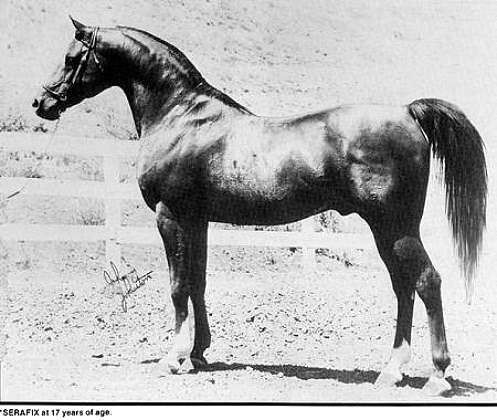
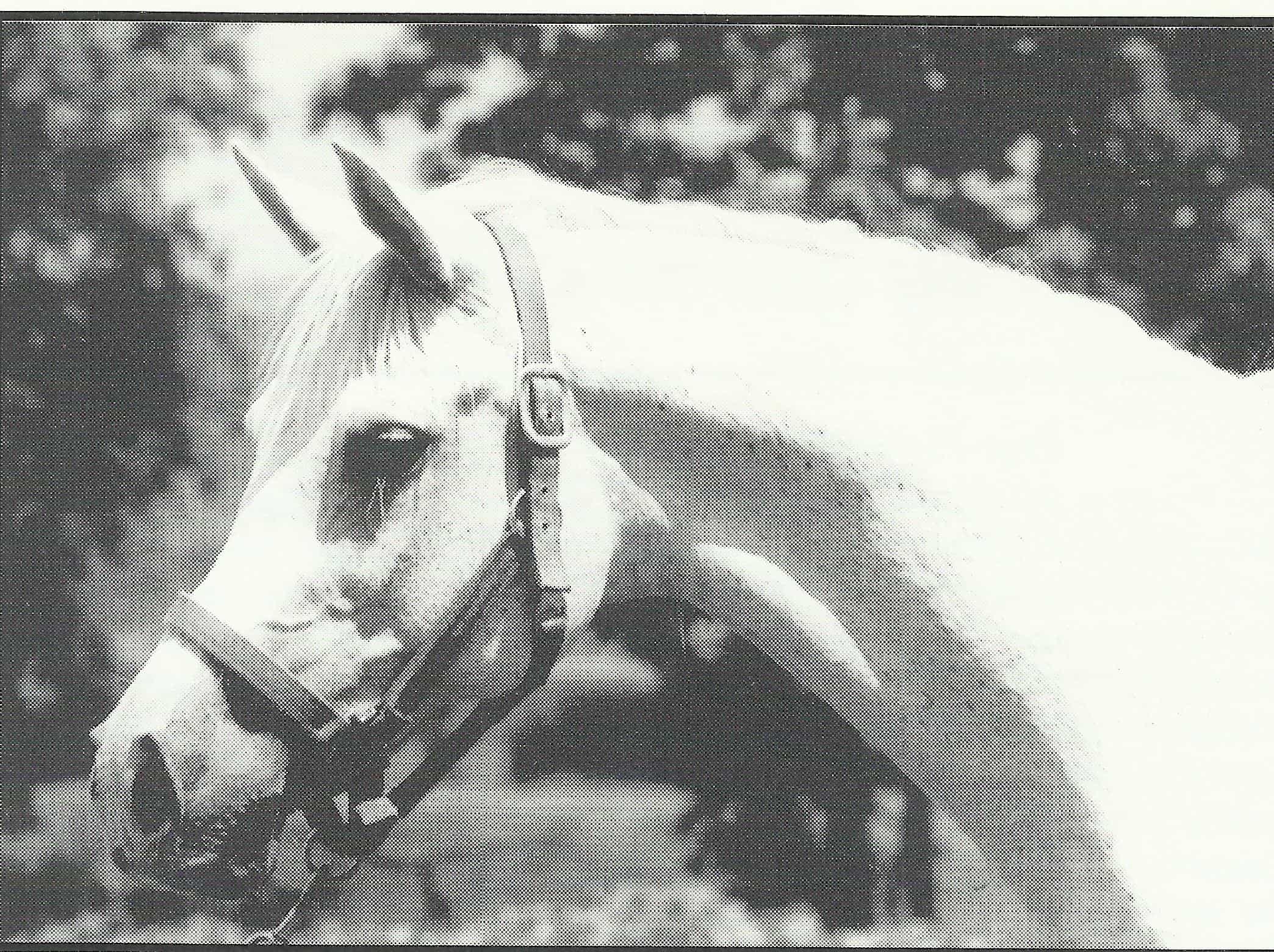

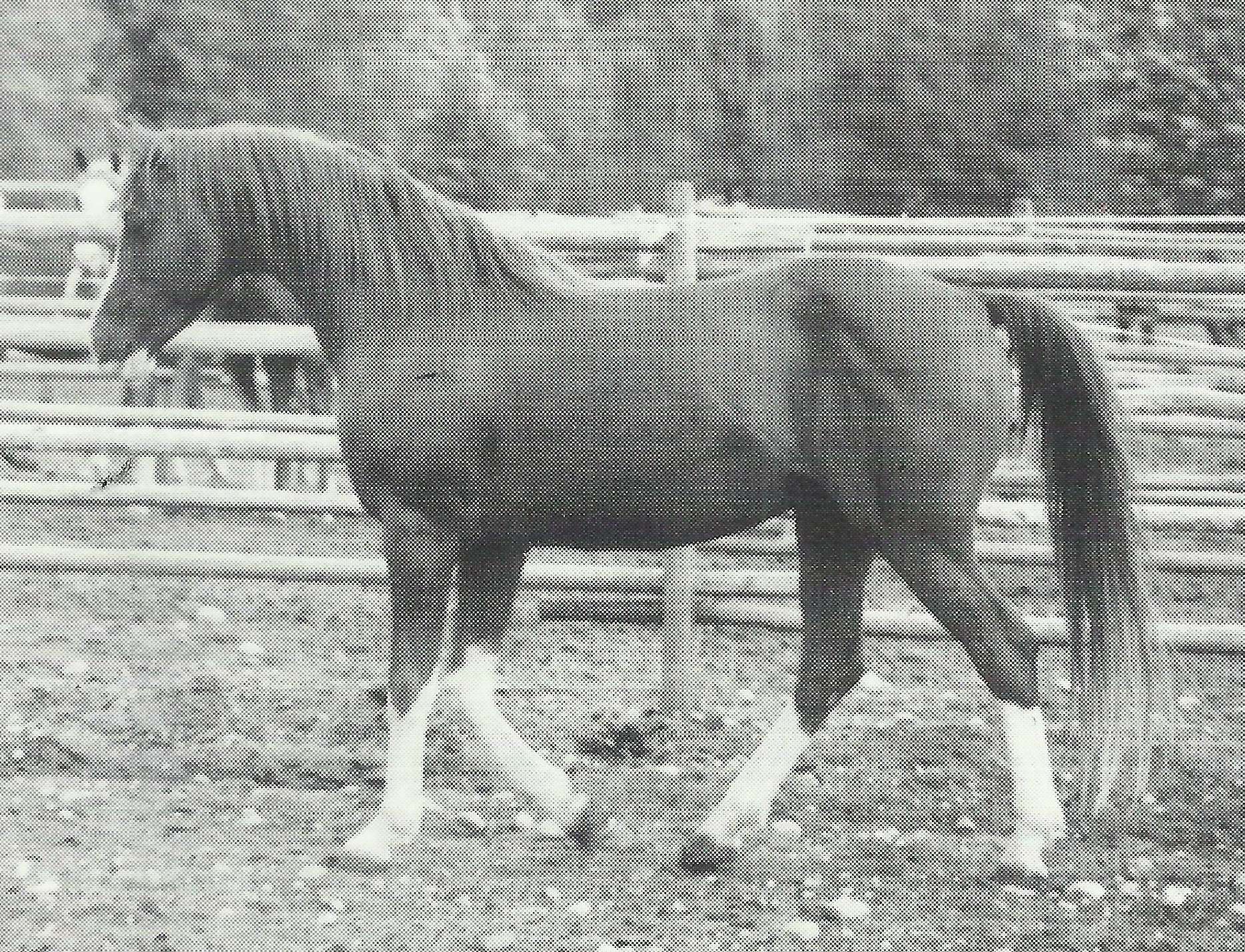
Comments
No Comments